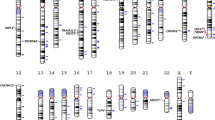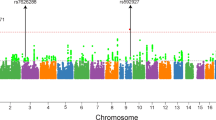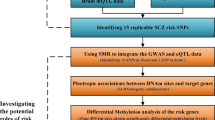Abstract
A recent genome-wide association study reported association between schizophrenia and the ZNF804A gene on chromosome 2q32.1. We attempted to replicate these findings in our Irish Case–Control Study of Schizophrenia (ICCSS) sample (N=1021 cases, 626 controls). Following consultation with the original investigators, we genotyped three of the most promising single-nucleotide polymorphisms (SNPs) from the Cardiff study. We replicate association with rs1344706 (trend test one-tailed P=0.0113 with the previously associated A allele) in ZNF804A. We detect no evidence of association with rs6490121 in NOS1 (one-tailed P=0.21), and only a trend with rs9922369 in RGRIP1L (one-tailed P=0.0515). On the basis of these results, we completed genotyping of 11 additional linkage disequilibrium-tagging SNPs in ZNF804A. Of 12 SNPs genotyped, 11 pass quality control criteria and 4 are nominally associated, with our most significant evidence of association at rs7597593 (P=0.0013) followed by rs1344706. We observe no evidence of differential association in ZNF804A on the basis of family history or sex of case. The associated SNP rs1344706 lies in ∼30 bp of conserved mammalian sequence, and the associated A allele is predicted to maintain binding sites for the brain-expressed transcription factors MYT1l and POU3F1/OCT-6. In controls, expression is significantly increased from the A allele of rs1344706 compared with the C allele. Expression is increased in schizophrenic cases compared with controls, but this difference does not achieve statistical significance. This study replicates the original reported association of ZNF804A with schizophrenia and suggests that there is a consistent link between the A allele of rs1344706, increased expression of ZNF804A and risk for schizophrenia.
This is a preview of subscription content, access via your institution
Access options
Subscribe to this journal
Receive 12 print issues and online access
$259.00 per year
only $21.58 per issue
Buy this article
- Purchase on Springer Link
- Instant access to full article PDF
Prices may be subject to local taxes which are calculated during checkout

Similar content being viewed by others
References
Kendler KS . Diehl SRThe genetics of schizophrenia: a current genetic-epidemiologic perspective. Schizophrenia Bulletin 1993; 19: 261–285.
Maki P, Veijola J, Jones PB, Murray GK, Koponen H, Tienari P et al. Predictors of schizophrenia—a review. Br Med Bull 2005; 73–74: 1–15.
Risch N, Merikangas K . The future of genetic studies of complex human diseases. Science 1996; 273: 1516–1517.
Klein RJ, Zeiss C, Chew EY, Tsai JY, Sackler RS, Haynes C et al. Complement factor H polymorphism in age-related macular degeneration. Science 2005; 308: 385–389.
Smyth DJ, Cooper JD, Bailey R, Field S, Burren O, Smink LJ et al. A genome-wide association study of nonsynonymous SNPs identifies a type 1 diabetes locus in the interferon-induced helicase (IFIH1) region. Nat Genet 2006; 38: 617–619.
Saxena R, Voight BF, Lyssenko V, Burtt NP, de Bakker PI, Chen H et al. Genome-wide association analysis identifies loci for type 2 diabetes and triglyceride levels. Science 2007; 316: 1331–1336.
Scott LJ, Mohlke KL, Bonnycastle LL, Willer CJ, Li Y, Duren WL et al. A genome-wide association study of type 2 diabetes in finns detects multiple susceptibility variants. Science 2007; 316: 1341–1345.
Sladek R, Rocheleau G, Rung J, Dina C, Shen L, Serre D et al. A genome-wide association study identifies novel risk loci for type 2 diabetes. Nature 2007; 445: 881–885.
Steinthorsdottir V, Thorleifsson G, Reynisdottir I, Benediktsson R, Jonsdottir T, Walters GB et al. A variant in CDKAL1 influences insulin response and risk of type 2 diabetes. Nat Genet 2007; 39: 770–775.
Zeggini E, Weedon MN, Lindgren CM, Frayling TM, Elliott KS, Lango H et al. Replication of genome-wide association signals in U.K.samples reveals risk loci for type 2 diabetes. Science 2007; 316: 1336–1341.
Groves CJ, Zeggini E, Minton J, Frayling TM, Weedon MN, Rayner NW et al. Association analysis of 6736 U.K.subjects provides replication and confirms TCF7L2 as a type 2 diabetes susceptibility gene with a substantial effect on individual risk. Diabetes 2006; 55: 2640–2644.
Papassotiropoulos A, Stephan DA, Huentelman MJ, Hoerndli FJ, Craig DW, Pearson JV et al. Common Kibra alleles are associated with human memory performance. Science 2006; 314: 475–478.
Duerr RH, Taylor KD, Brant SR, Rioux JD, Silverberg MS, Daly MJ et al. A genome-wide association study identifies IL23R as an inflammatory bowel disease gene. Science 2006; 314: 1461–1463.
Hampe J, Franke A, Rosenstiel P, Till A, Teuber M, Huse K et al. A genome-wide association scan of nonsynonymous SNPs identifies a susceptibility variant for Crohn disease in ATG16L1. Nat Genet 2007; 39: 207–211.
Rioux JD, Xavier RJ, Taylor KD, Silverberg MS, Goyette P, Huett A et al. Genome-wide association study identifies new susceptibility loci for Crohn disease and implicates autophagy in disease pathogenesis. Nat Genet 2007; 39: 596–604.
Libioulle C, Louis E, Hansoul S, Sandor C, Farnir F, Franchimont D et al. Novel Crohn disease locus identified by genome-wide association maps to a gene desert on 5p13.1 and modulates expression of PTGER4. PLoS Genet 2007; 3: e58.
Gudmundsson J, Sulem P, Manolescu A, Amundadottir LT, Gudbjartsson D, Helgason A et al. Genome-wide association study identifies a second prostate cancer susceptibility variant at 8q24. Nat Genet 2007; 39: 631–637.
Haiman CA, Patterson N, Freedman ML, Myers SR, Pike MC, Waliszewska A et al. Multiple regions within 8q24 independently affect risk for prostate cancer. Nat Genet 2007; 39: 638–644.
Yeager M, Orr N, Hayes RB, Jacobs KB, Kraft P, Wacholder S et al. Genome-wide association study of prostate cancer identifies a second risk locus at 8q24. Nat Genet 2007; 39: 645–649.
Frayling TM, Timpson NJ, Weedon MN, Zeggini E, Freathy RM, Lindgren CM et al. A common variant in the FTO gene is associated with body mass index and predisposes to childhood and adult obesity. Science 2007; 316: 889–894.
Lencz T, Morgan TV, Athanasiou M, Dain B, Reed CR, Kane JM et al. Converging evidence for a pseudoautosomal cytokine receptor gene locus in schizophrenia. Mol Psychiatry 2007; 12: 572–580.
Sullivan PF, Lin D, Tzeng JY, van den OE, Perkins D, Stroup TS et al. Genomewide association for schizophrenia in the CATIE study: results of stage 1. Mol Psychiatry 2008; 13: 570–584.
O′Donovan MC, Craddock N, Norton N, Williams H, Peirce T, Moskvina V et al. Identification of loci associated with schizophrenia by genome-wide association and follow-up. Nat Genet 2008; 40: 1053–1055.
Sun S, Wang F, Wei J, Cao LY, Wu GY, Lu L et al. Association between interleukin-3 receptor alpha polymorphism and schizophrenia in the Chinese population. Neurosci Lett 2008; 440: 35–37.
Lieberman JA, Stroup TS, McEvoy JP, Swartz MS, Rosenheck RA, Perkins DO et al. Effectiveness of antipsychotic drugs in patients with chronic schizophrenia. N Engl J Med 2005; 353: 1209–1223.
Wellcome Trust Case Control Consortium. Genome-wide association study of 14 000 cases of seven common diseases and 3000 shared controls. Nature 2007; 447: 661–678.
Spitzer RL, Williams JB, Gibbon J . Structured Clinical Interview for DSM-III-R - Patient Version (SCID-P (4/1/87). New York State Psychiatric Institute: New York, 1987.
Kendler KS, O′Neill FA, Burke J, Murphy B, Duke F, Straub RE et al. Irish study on high-density schizophrenia families: field methods and power to detect linkage. Am J Med Genet 1996; 67: 179–190.
Cavalli-Sforza LL, Menozzi P, Piazza A . The History Geography of Human Genes. Princeton University Press: Princeton, NJ, 1994.
Relethford JH . Genetic structure and population history of Ireland: a comparison of blood group and anthropometric analyses. Ann Hum Biol 1983; 10: 321–333.
Sunderland E, Tills D, Bouloux C, Doyle J . Genetic studies in Ireland. In: Roberts DF, Sunderland E (eds). Genetic Variation in Britain, Taylor & Francis: London, UK, 1973, pp 141–170.
Hill EW, Jobling MA . Bradley DGY-chromosome variation Irish origins. Nature 2000; 404: 351–352.
Semino O, Passarino G, Oefner PJ, Lin AA, Arbuzova S, Beckman LE et al. The genetic legacy of Paleolithic Homo sapiens sapiens in extant Europeans: a Y chromosome perspective. Science 2000; 290: 1155–1159.
McEvoy B, Richards M, Forster P, Bradley DG . The Longue Duree of genetic ancestry: multiple genetic marker systems and Celtic origins on the Atlantic facade of Europe. Am J Hum Genet 2004; 75: 693–702.
Andreasen NC, Endicott J, Spitzer RL, Winokur G . The family history method using diagnostic criteria. Reliability and validity. Arch Gen Psychiatry 1977; 34: 1229–1235.
Endicott J, Andreasen N, Spitzer RL . Family History Research Diagnostic Criteria. New York State Psychiatric Institute: New York, 1978.
Roy MA, Walsh D, Kendler KS . Accuracies and inaccuracies of the family history method: a multivariate approach. Acta Psychiatr Scand 1996)); 93: 224–234.
Andreasen NC, Endicott J, Spitzer RL, Winokur G . The family history method using diagnostic criteria. Reliability and validity. Arch Gen Psychiatry 1977; 34: 1229–1235.
de Bakker PI, Yelensky R, Pe′er I, Gabriel SB, Daly MJ, Altshuler D . Efficiency and power in genetic association studies. Nat Genet 2005; 37: 1217–1223.
Barrett JC, Fry B, Maller J, Daly MJ . Haploview: analysis and visualization of LD and haplotype maps. Bioinformatics 2005; 21: 263–265.
Van den Oord EJCG, Jiang Y, Riley BP, Kendler KS, Chen X . FP-TDI SNP genotype scoring by manual and statistical procedures: A study of error rates and types. Biotechniques 2003; 34: 610–624.
SAS Institute SAS (v9) Cary NC. Ref Type: Computer Program 2002.
Sasieni PD . From genotypes to genes: doubling the sample size. Biometrics 1997; 53: 1253–1261.
O′Dushlaine CT, Dolan C, Weale ME, Stanton A, Croke DT, Kalviainen R et al. An assessment of the Irish population for large-scale genetic mapping studies involving epilepsy and other complex diseases. Eur J Hum Genet 2007; 16: 176–183.
Gabriel SB, Schaffner SF, Nguyen H, Moore JM, Roy J, Blumensteil B et al. The structure of haplotype blocks in the human genome. Science 2002; 296: 2225–2229.
Torrey EF, Webster M, Knable M, Johnston N, Yolken RH . The stanley foundation brain collection and neuropathology consortium. Schizophr Res 2000; 44: 151–155.
Vandesompele J, De Preter K, Pattyn F, Poppe B, Van Roy N, De Paepe A et al. Accurate normalization of real-time quantitative RT-PCR data by geometric averaging of multiple internal control genes. Genome Biol 2002; 3: research0034.1–research0034.11.
Livak KJ, Schmittgen TD . Analysis of relative gene expression data using real-time quantitative PCR and the 2(-Delta Delta C(T)) Method. Methods 2001; 25: 402–408.
Anderson TW, Darling DA . Asymptotic theory of certain ‘goodness-of-fit’ criteria based on stochastic processes. Ann Math Stat 1952; 23: 193–212.
Stephens MA . EDF statistics for Goodness of Fit Some Comparisons. J Am Stat Assoc 1974; 69: 730–737.
Cartharius K, Frech K, Grote K, Klocke B, Haltmeier M, Klingenhoff A et al. MatInspector and beyond: promoter analysis based on transcription factor binding sites. Bioinformatics 2005; 21: 2933–2942.
Page GP, Amos CI . Comparison of linkage-disequilibrium methods for localization of genes influencing quantitative traits in humans. Am J Hum Genet 1999; 64: 1194–1205.
Kim JG, Armstrong RC, Agoston D, Robinsky A, Wiese C, Nagle J et al. Myelin transcription factor 1 (Myt1) of the oligodendrocyte lineage, along with a closely related CCHC zinc finger, is expressed in developing neurons in the mammalian central nervous system. J Neurosci Res 1997; 50: 272–290.
Nielsen JA, Berndt JA, Hudson LD, Armstrong RC . Myelin transcription factor 1 (Myt1) modulates the proliferation and differentiation of oligodendrocyte lineage cells. Mol Cell Neurosci 2004; 25: 111–123.
Collarini EJ, Kuhn R, Marshall CJ, Monuki ES, Lemke G, Richardson WD . Down-regulation of the POU transcription factor SCIP is an early event in oligodendrocyte differentiation in vitro. Development 1992; 116: 193–200.
Bayarsaihan D, Enkhmandakh B, Makeyev A, Greally JM, Leckman JF . Ruddle FH Homez a homeobox leucine zipper gene specific to the vertebrate lineage. Proc Natl Acad Sci USA 2003; 100: 10358–10363.
Wang W, Chan EK, Baron S, Van de WT, Lufkin T . Hmx2 homeobox gene control of murine vestibular morphogenesis. Development 2001; 128: 5017–5029.
de Geus EJ, Posthuma D, Kupper N, van den BM, Willemsen G, Beem AL et al. A whole-genome scan for 24-hour respiration rate: a major locus at 10q26 influences respiration during sleep. Am J Hum Genet 2005; 76: 100–111.
Wang W, Lufkin T . Hmx homeobox gene function in inner ear and nervous system cell-type specification and development. Exp Cell Res 2005; 306: 373–379.
Jaegle M, Mandemakers W, Broos L, Zwart R, Karis A, Visser P et al. The POU factor Oct-6 and Schwann cell differentiation. Science 1996; 273: 507–510.
Ubhi K, Price J . Expression of POU-domain transcription factor, Oct-6, in schizophrenia, bipolar disorder and major depression. BMC Psychiatry 2005; 5: 38.
Acknowledgements
This work was supported by the National Institute of Mental Health Grant R01-MH41953 to KSK/BR. AF was supported by a Department of Veterans Affairs Merit Review award. We thank X Chen for genotyping macros and sex determination data and the Northern Ireland Blood Transfusion Services for their invaluable assistance in control sampling.
Author information
Authors and Affiliations
Corresponding author
Additional information
Supplementary Information accompanies the paper on the Molecular Psychiatry website (http://www.nature.com/mp)
Rights and permissions
About this article
Cite this article
Riley, B., Thiselton, D., Maher, B. et al. Replication of association between schizophrenia and ZNF804A in the Irish Case–Control Study of Schizophrenia sample. Mol Psychiatry 15, 29–37 (2010). https://doi.org/10.1038/mp.2009.109
Received:
Revised:
Accepted:
Published:
Issue Date:
DOI: https://doi.org/10.1038/mp.2009.109
Keywords
This article is cited by
-
Schizophrenia risk ZNF804A interacts with its associated proteins to modulate dendritic morphology and synaptic development
Molecular Brain (2021)
-
ZFP804A mutant mice display sex-dependent schizophrenia-like behaviors
Molecular Psychiatry (2021)
-
Hyperfunctioning of the right posterior superior temporal sulcus in response to neutral facial expressions presents an endophenotype of schizophrenia
Neuropsychopharmacology (2020)
-
Family-based association study of ZNF804A polymorphisms and autism in a Han Chinese population
BMC Psychiatry (2019)
-
Interactome analysis reveals ZNF804A, a schizophrenia risk gene, as a novel component of protein translational machinery critical for embryonic neurodevelopment
Molecular Psychiatry (2018)



